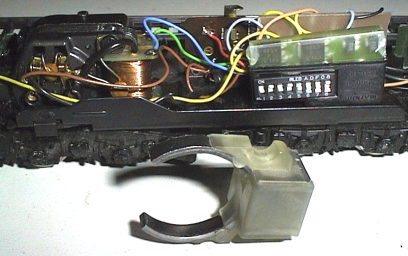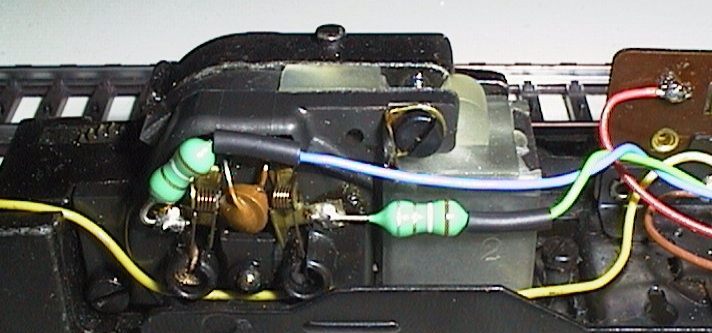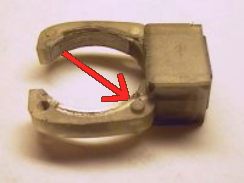
Updated 27 Sep. 2002
08-12-2013 Note !: This article was written in 2002 and since then, retrofitting has become somewhat easier, and better components has become available from Märklin. There are the 60943 which has an all new motor for older Locos with SCFM motors, and the 60944 for Locos with LFCM motors. After the motor has been upgraded, you need a decoder. Also here Märklin now has a bigger selection including sound decoders. Else ESU's Lokpilot or loksound are great decoders, and in some cases more versatile and cheaper. Mounting boards are also avaliable if you want to use 21 pin decoders - this will make soldering less critical. |
As you may know the advantages with the 6090(x) system is :
In order to convert a loc to 6090(x), your loc must normally be fitted with a drum-commutator.
It IS possible to get all the advantages of the 6090(x), even if you have an older loc, who use :
LFCM (Large Flat Collector Motor) Or SFCM (Small Flat Collector Motor)
What you need is a permanent magnet which can replace the electromagnet, that the loc is fitted with.
The magnets from the HAMO-locs, are just what you should use.
If you have locs based on a LFCM, then you need the 220560.
If you have locs based on a SFCM, then you need the 220450.
A comparison between the two magnets (62K)
In principle, you can convert all locs with 6090(x), as long as you can fit the 6090(x) decoder in
the loc. However I have encountered several instants where the 220450 cannot be fitted, unless
you do some milling(cutting) in the motorshield.
If you concluded that the 220560 are the magnet you should use, then let me tell
you that there is an alternative to the 220560. It's a stronger magnet, and it consists
of a 220970 (which is a 220560 without the magnet) and two 7558 magnets.
The 7558 magnets are smaller than the normal magnet, so a spacer of some kind is
needed. I have made one in balsa-wood, which is soft and can be pressed to fit.
The spacer just need to fit, and be non-magnetical. From my experience with the
7558 magnets, I can say that the performance is a bit better than with the normal magnet.
The locomotives run a bit smoother.
 |
 |
 | |
I have been given some even stronger magnets - so strong that you can put on each side of
your hand, and they will stay there !. The magnet look very similar to those which can be bought
from Conrad. They look very much like them (small and round) but i don't know how strong
the ones from Conrad are.
BUT, I found these magnets to be almost too strong. At low speeds the motor frequently stalls
because the magnets almost "locks" the anchor. They seem to work better in large locos, because
of the bigger momentum, but in small locos its not that great.
So maybe there are such a thing as a too strong magnet.
 |
Click to enlarge picture ! | |
So - what do you do ?.
Of course you start of by buying a magnet and a decoder - The decoder would be the 60901.
You could also by the 60902, which is the decoder ONLY. This way you don't have
to pay for a magnet you don't use.
Ok ! - The following is how I converted a 3022(E94) using a 220560.
Start by unsoldering the wires from the existing decoder/direction changer and the electromagnet.
 |
Now simply mount the magnet, where the electromagnet used to be, - It should fit perfectly.
Here's a comparison between the HAMO-magnet and the Electro-magnet (44K)
Now solder the wires as described in the 6090 booklet. - It's that simple ! (for the 6090x decoders go here)
 |
|
(71K) (89K) |
The 220560 (73K) The 220560 with magnet taken out (84K) The 220560 with magnet taken out, viewed from another angle (69K) |
 In case you want to convert a loc using a SFCM(220450), I have
made a couple of pictures of that.
In case you want to convert a loc using a SFCM(220450), I have
made a couple of pictures of that.
The pictures show how the 220450 fit in a 3000 (BR89), which are
one of Märklin's smallest locomotives. The pictures only show how
the magnets fits NOT the decoder, as I am not sure a 6090(x) would
fit in a 3000.
But as I stated before,
IT SHOULD BE POSSIBLE TO CONVERT ANY MÄRKLIN
LOCOMOTIVE AS LONG AS YOU CAN FIT THE DECODER !
It may be necessary to cut the small plastic dots (look at the picture) smaller or cut them away, in order
to fit the 220450 on very old locos. You shouldn't worry about cutting the dots, as the two screws are
enough to hold the magnet in place. I have tried cutting the dot smaller by cutting a bit off from 4 sides,
so the round dot becomes a small square dot. But be aware that milling may be required to the motor-
shield in order for it to fit over the magnet.
The SFCM anchor (27K) |
Note. This loc are not being converted. The pictures are ONLY to illustrate that it it can be done(the magnet fits!) this is why you also see the electromagnet on the pictures. A view of the magnet + anchor mounted (62K) Close-up of the above. (86K) *Note the free space between the anchor and the magnet ! |